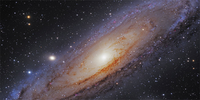当前位置:
X-MOL 学术
›
Phys. Rev. Lett.
›
论文详情
Our official English website, www.x-mol.net, welcomes your
feedback! (Note: you will need to create a separate account there.)
Self-Interacting Dark Matter Can Explain Diverse Galactic Rotation Curves
Physical Review Letters ( IF 8.1 ) Pub Date : 2017-09-13 00:00:00 , DOI: 10.1103/physrevlett.119.111102 Ayuki Kamada , Manoj Kaplinghat , Andrew B. Pace , Hai-Bo Yu
Physical Review Letters ( IF 8.1 ) Pub Date : 2017-09-13 00:00:00 , DOI: 10.1103/physrevlett.119.111102 Ayuki Kamada , Manoj Kaplinghat , Andrew B. Pace , Hai-Bo Yu

|
The rotation curves of spiral galaxies exhibit a diversity that has been difficult to understand in the cold dark matter (CDM) paradigm. We show that the self-interacting dark matter (SIDM) model provides excellent fits to the rotation curves of a sample of galaxies with asymptotic velocities in the range that exemplify the full range of diversity. We assume only the halo concentration-mass relation predicted by the CDM model and a fixed value of the self-interaction cross section. In dark-matter-dominated galaxies, thermalization due to self-interactions creates large cores and reduces dark matter densities. In contrast, thermalization leads to denser and smaller cores in more luminous galaxies and naturally explains the flatness of rotation curves of the highly luminous galaxies at small radii. Our results demonstrate that the impact of the baryons on the SIDM halo profile and the scatter from the assembly history of halos as encoded in the concentration-mass relation can explain the diverse rotation curves of spiral galaxies.
中文翻译:

自相互作用的暗物质可以解释不同的银河旋转曲线
螺旋星系的自转曲线表现出多样性,在冷暗物质(CDM)范式中很难理解。我们表明,自相互作用暗物质(SIDM)模型可以很好地拟合具有渐近速度的星系样本的旋转曲线。代表整个多样性范围的范围。我们仅假设CDM模型预测的晕圈浓度与质量的关系以及自相互作用截面的固定值。在以暗物质为主的星系中,由于自身相互作用而产生的热作用会形成较大的核,并降低暗物质的密度。相比之下,热化会导致更多发光的星系中的密度更大,核心更小,自然地解释了高发光的星系在小半径时旋转曲线的平坦性。我们的结果表明,重子对SIDM光晕轮廓的影响以及浓度-质量关系中编码的光环组装历史的散布可以解释旋涡星系的各种旋转曲线。
更新日期:2017-09-13
中文翻译:

自相互作用的暗物质可以解释不同的银河旋转曲线
螺旋星系的自转曲线表现出多样性,在冷暗物质(CDM)范式中很难理解。我们表明,自相互作用暗物质(SIDM)模型可以很好地拟合具有渐近速度的星系样本的旋转曲线。代表整个多样性范围的范围。我们仅假设CDM模型预测的晕圈浓度与质量的关系以及自相互作用截面的固定值。在以暗物质为主的星系中,由于自身相互作用而产生的热作用会形成较大的核,并降低暗物质的密度。相比之下,热化会导致更多发光的星系中的密度更大,核心更小,自然地解释了高发光的星系在小半径时旋转曲线的平坦性。我们的结果表明,重子对SIDM光晕轮廓的影响以及浓度-质量关系中编码的光环组装历史的散布可以解释旋涡星系的各种旋转曲线。











































 京公网安备 11010802027423号
京公网安备 11010802027423号